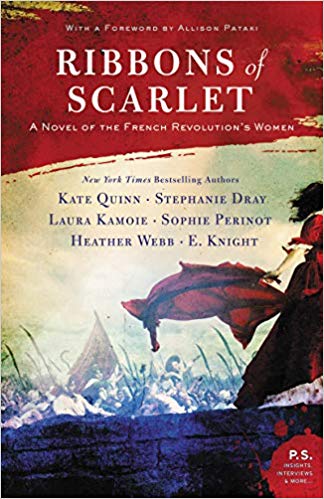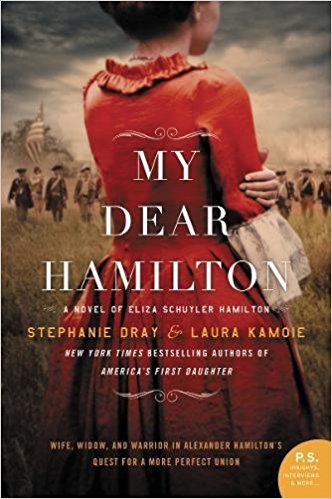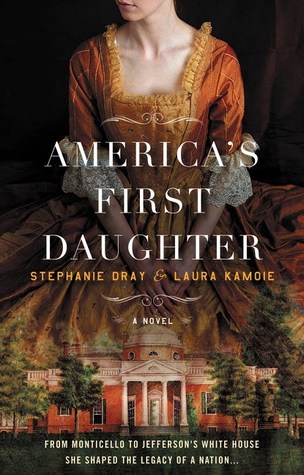 Ribbons of Scarlet: A Novel of the French Revolution's Women by Kate Quinn, Stephanie Dray, Laura Kamoie, E. Knight, Sophie Perinot, Heather Webb, Allison Pataki
Ribbons of Scarlet: A Novel of the French Revolution's Women by Kate Quinn, Stephanie Dray, Laura Kamoie, E. Knight, Sophie Perinot, Heather Webb, Allison Pataki Format: eARC
Source: supplied by publisher via Edelweiss
Formats available: hardcover, paperback, large print, ebook, audiobook
Genres: historical fiction, women's history
Pages: 560
Published by William Morrow Paperbacks on October 1, 2019
Purchasing Info: Author's Website, Publisher's Website, Amazon, Barnes & Noble, Kobo, Bookshop.org
Goodreads
Six bestselling and award-winning authors bring to life a breathtaking epic novel illuminating the hopes, desires, and destinies of princesses and peasants, harlots and wives, fanatics and philosophers—six unforgettable women whose paths cross during one of the most tumultuous and transformative events in history: the French Revolution.
Ribbons of Scarlet is a timely story of the power of women to start a revolution—and change the world.
In late eighteenth-century France, women do not have a place in politics. But as the tide of revolution rises, women from gilded salons to the streets of Paris decide otherwise—upending a world order that has long oppressed them.
Blue-blooded Sophie de Grouchy believes in democracy, education, and equal rights for women, and marries the only man in Paris who agrees. Emboldened to fight the injustices of King Louis XVI, Sophie aims to prove that an educated populace can govern itself--but one of her students, fruit-seller Louise Audu, is hungrier for bread and vengeance than learning. When the Bastille falls and Louise leads a women’s march to Versailles, the monarchy is forced to bend, but not without a fight. The king’s pious sister Princess Elisabeth takes a stand to defend her brother, spirit her family to safety, and restore the old order, even at the risk of her head.
But when fanatics use the newspapers to twist the revolution’s ideals into a new tyranny, even the women who toppled the monarchy are threatened by the guillotine. Putting her faith in the pen, brilliant political wife Manon Roland tries to write a way out of France’s blood-soaked Reign of Terror while pike-bearing Pauline Leon and steely Charlotte Corday embrace violence as the only way to save the nation. With justice corrupted by revenge, all the women must make impossible choices to survive--unless unlikely heroine and courtesan’s daughter Emilie de Sainte-Amaranthe can sway the man who controls France’s fate: the fearsome Robespierre.
My Review:
Women have always fought. We have always lived in the castle. We have always defended the castle, and stormed the castle as well. We have always been there, on the front lines as well as behind the scenes, no matter how much we are written out of the supposedly official histories of “great men and great deeds” that try to pretend that we weren’t in the room where it happened – or on the ramparts defending that room.
The enduring images of the parts that women played in the French Revolution can (unfortunately) be reduced to three, not that there weren’t plenty of women involved, but history as written goes back to those “great men and great deeds” so that women’s contributions can be swept under the carpet – as sweeping was considered an appropriate activity for women.
When we think of women in relation to the French Revolution, the images that have stuck are poor, waifish Cosette from Les Misérables, the over-pampered and over-privileged Queen, Marie Antoinette crying, “Let them eat cake!” and the villainous Madame Defarge from A Tale of Two Cities, knitting and cackling as the guillotine falls.



I’m just realizing that those three women conveniently fall into the “maiden, mother, crone” triptych and wondering if that’s what has made those particular three so memorable. I digress.
Ribbons of Scarlet, fictional though it is, tries to go deeper into the roles that women played during the Revolution. I almost said “both sides” but that implies that the sides were MUCH more clearly defined than they actually were. The Revolution, as the saying went, ate its young.
Instead of straightforwardly proceeding through the story of the French Revolution, or even telling it as a braided novel like The Glass Ocean by “Team W”, Ribbons of Scarlet proceeds from the very beginnings of the Revolution to its exhausted ending at the ascension of Napoleon Bonaparte through narratives that focus on the part that each woman played in her point in history – then she hands the story off to the next woman until it comes full circle back to the original narrator.
Each woman’s story is written by a different author, telling the story of the French Revolution almost as a relay race rather than a single story. Grouchette passes the baton to Louise who in her turn passes it to Elisabeth to Manon to Charlotte to Emilie and, at last, back to Grouchette.
All of these women, including, surprisingly, the revolutionary Louise Audu, were historical figures. Manon and Sophie were prolific authors, and the words and views ascribed to them in the story are documentably their own.
We have always fought. Sometimes with words – and sometimes with pikes.
Escape(ish) Rating: B+: To say that the French Revolution, for all its noble aims, turned out to be a clusterfuck implies a level of organization that doesn’t seem to have actually been present. After reading Ribbons of Scarlet, it feels more like the French Revolution was a goat rope. (Now there’s a term I never thought I’d have a use for, but my word the whole thing was completely fucked.) Reading this book makes me wonder how France managed to get itself organized back into a country – ever. So many histories focus on “great men” and “progress” that the level of sheer savagery gets reduced to something bearable. It probably has to, or history classes would need trigger warnings for this section – not that that’s necessarily a bad thing.
However, just because all of the women were real doesn’t make them all equally interesting, or at least written equally sympathetically. In some ways, Ribbons of Scarlet feels like a short story collection on a single theme, and like all collections some stories work better than others. That being said, Grouchette’s section coming at the beginning was a great way to get into the story. I liked her and I found her perspectives surprisingly easy to identify with.
At the same time, Elizabeth’s extreme piety and unassailable belief in the divine right of kings, as well as Louise’ and Manon’s internal dialog about their own sexuality, while they feel right for their time, make hard reading in ours.
But they ALL advance the story, it’s just that some heads are more interesting to be inside of than others – whether or not those heads eventually got cut off or not. Most of their fates were tragic in one way or another. That their voices have been lost to history – that’s the real tragedy.


 My Dear Hamilton: A Novel of Eliza Schuyler Hamilton by
My Dear Hamilton: A Novel of Eliza Schuyler Hamilton by  At the end of the play
At the end of the play  America's First Daughter by
America's First Daughter by 
